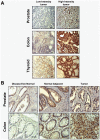Expression of the stress response oncoprotein LEDGF/p75 in human cancer: a study of 21 tumor types
- PMID: 22276150
- PMCID: PMC3261859
- DOI: 10.1371/journal.pone.0030132
Expression of the stress response oncoprotein LEDGF/p75 in human cancer: a study of 21 tumor types
Abstract
Oxidative stress-modulated signaling pathways have been implicated in carcinogenesis and therapy resistance. The lens epithelium derived growth factor p75 (LEDGF/p75) is a transcription co-activator that promotes resistance to stress-induced cell death. This protein has been implicated in inflammatory and autoimmune conditions, HIV-AIDS, and cancer. Although LEDGF/p75 is emerging as a stress survival oncoprotein, there is scarce information on its expression in human tumors. The present study was performed to evaluate its expression in a comprehensive panel of human cancers. Transcript expression was examined in the Oncomine cancer gene microarray database and in a TissueScan Cancer Survey Panel quantitative polymerase chain reaction (Q-PCR) array. Protein expression was assessed by immunohistochemistry (IHC) in cancer tissue microarrays (TMAs) containing 1735 tissues representing single or replicate cores from 1220 individual cases (985 tumor and 235 normal tissues). A total of 21 major cancer types were analyzed. Analysis of LEDGF/p75 transcript expression in Oncomine datasets revealed significant upregulation (tumor vs. normal) in 15 out of 17 tumor types. The TissueScan Cancer Q-PCR array revealed significantly elevated LEDGF/p75 transcript expression in prostate, colon, thyroid, and breast cancers. IHC analysis of TMAs revealed significant increased levels of LEDGF/p75 protein in prostate, colon, thyroid, liver and uterine tumors, relative to corresponding normal tissues. Elevated transcript or protein expression of LEDGF/p75 was observed in several tumor types. These results further establish LEDGF/p75 as a cancer-related protein, and provide a rationale for ongoing studies aimed at understanding the clinical significance of its expression in specific human cancers.
Conflict of interest statement
Figures




Similar articles
-
LEDGF/p75 Overexpression Attenuates Oxidative Stress-Induced Necrosis and Upregulates the Oxidoreductase ERP57/PDIA3/GRP58 in Prostate Cancer.PLoS One. 2016 Jan 15;11(1):e0146549. doi: 10.1371/journal.pone.0146549. eCollection 2016. PLoS One. 2016. PMID: 26771192 Free PMC article.
-
Pathway specific gene expression profiling reveals oxidative stress genes potentially regulated by transcription co-activator LEDGF/p75 in prostate cancer cells.Prostate. 2012 May 1;72(6):597-611. doi: 10.1002/pros.21463. Epub 2011 Jul 27. Prostate. 2012. PMID: 21796653 Free PMC article.
-
The stress oncoprotein LEDGF/p75 interacts with the methyl CpG binding protein MeCP2 and influences its transcriptional activity.Mol Cancer Res. 2012 Mar;10(3):378-91. doi: 10.1158/1541-7786.MCR-11-0314. Epub 2012 Jan 24. Mol Cancer Res. 2012. PMID: 22275515 Free PMC article.
-
Role of LEDGF/p75 (PSIP1) in oncogenesis. Insights in molecular mechanism and therapeutic potential.Biochim Biophys Acta Rev Cancer. 2025 Feb;1880(1):189248. doi: 10.1016/j.bbcan.2024.189248. Epub 2024 Dec 18. Biochim Biophys Acta Rev Cancer. 2025. PMID: 39701326 Review.
-
The Emerging Roles of the Stress Epigenetic Reader LEDGF/p75 in Cancer Biology and Therapy Resistance: Mechanisms and Targeting Opportunities.Cancers (Basel). 2024 Nov 26;16(23):3957. doi: 10.3390/cancers16233957. Cancers (Basel). 2024. PMID: 39682146 Free PMC article. Review.
Cited by
-
Glucocorticoids Induce Stress Oncoproteins Associated with Therapy-Resistance in African American and European American Prostate Cancer Cells.Sci Rep. 2018 Oct 10;8(1):15063. doi: 10.1038/s41598-018-33150-2. Sci Rep. 2018. PMID: 30305646 Free PMC article.
-
Twenty years of research on the DFS70/LEDGF autoantibody-autoantigen system: many lessons learned but still many questions.Auto Immun Highlights. 2020 Feb 3;11(1):3. doi: 10.1186/s13317-020-0126-4. Auto Immun Highlights. 2020. PMID: 32127038 Free PMC article. Review.
-
The significance of autoantibodies to DFS70/LEDGFp75 in health and disease: integrating basic science with clinical understanding.Clin Exp Med. 2016 Aug;16(3):273-93. doi: 10.1007/s10238-015-0367-0. Epub 2015 Jun 19. Clin Exp Med. 2016. PMID: 26088181 Free PMC article. Review.
-
Polymorphism rs2395655 affects LEDGF/p75 binding activity and p21WAF1/CIP1 gene expression in esophageal squamous cell carcinoma.Cancer Med. 2019 May;8(5):2313-2324. doi: 10.1002/cam4.2067. Epub 2019 Mar 10. Cancer Med. 2019. PMID: 30854807 Free PMC article.
-
Genomic Characterization of Rare Primary Cardiac Sarcoma Entities.Diagnostics (Basel). 2023 Jan 6;13(2):214. doi: 10.3390/diagnostics13020214. Diagnostics (Basel). 2023. PMID: 36673024 Free PMC article.
References
-
- Pani G, Galeotti T, Chiarugi P. Metastasis: cancer cell's escape from oxidative stress. Cancer Metastasis Rev. 2010;29:351–378. - PubMed
-
- Mena S, Ortega A, Estrela JM. Oxidative stress in environmental-induced carcinogenesis. Mutat Res. 2009;674:36–44. - PubMed
-
- Singh DP, Ohguro N, Kikuchi T, Sueno T, Reddy VN, et al. Lens epithelium-derived growth factor: effects on growth and survival of lens epithelial cells, keratinocytes, and fibroblasts. Biochem Biophys Res Commun. 2000;267:373–381. - PubMed
-
- Sharma P, Singh DP, Fatma N, Chylack LT, Jr, Shinohara T. Activation of LEDGF gene by thermal-and oxidative-stresses. Biochem Biophys Res Commun. 2000;276:1320–1324. - PubMed
Publication types
MeSH terms
Substances
Grants and funding
LinkOut - more resources
Full Text Sources
Research Materials

